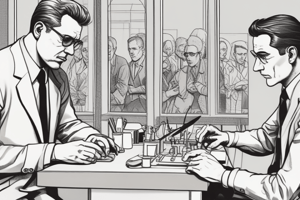Podcast
Questions and Answers
What was the background of the Milgram experiment?
What was the background of the Milgram experiment?
The background of the experiment involved researching justifications for acts of genocide because of World War II and the Holocaust.
What psychology was investigated in the Milgram experiment?
What psychology was investigated in the Milgram experiment?
The obedience of participants.
Define Agentic State.
Define Agentic State.
A state of mind where a person allows others to direct their behaviors and shift responsibility for the consequences.
What does Autonomous State refer to?
What does Autonomous State refer to?
What was the aim of the Milgram study?
What was the aim of the Milgram study?
What were the participant details of the Milgram study?
What were the participant details of the Milgram study?
What was the sampling method used in the Milgram study?
What was the sampling method used in the Milgram study?
How was the experiment designed?
How was the experiment designed?
What were the key procedures of the Milgram study?
What were the key procedures of the Milgram study?
What were the results of the Milgram study?
What were the results of the Milgram study?
What conclusions did Milgram reach from his study?
What conclusions did Milgram reach from his study?
What is a situational hypothesis according to Milgram?
What is a situational hypothesis according to Milgram?
Explain the dispositional hypothesis in relation to Milgram's experiment.
Explain the dispositional hypothesis in relation to Milgram's experiment.
The IV of the Milgram experiment was the ______.
The IV of the Milgram experiment was the ______.
The DV of the Milgram experiment was the ______.
The DV of the Milgram experiment was the ______.
What were the strengths of the Milgram study?
What were the strengths of the Milgram study?
Flashcards
Agentic State
Agentic State
The state of mind where an individual defers responsibility to an authority figure, allowing them to act without personal accountability.
Obedience to Authority
Obedience to Authority
Describes the tendency for individuals to obey authority figures, even when instructed to harm others, highlighting the power of social influence.
Autonomous State
Autonomous State
The mental state where an individual acts independently, deciding for themselves and taking responsibility for their actions.
Level of Obedience
Level of Obedience
Signup and view all the flashcards
Prods
Prods
Signup and view all the flashcards
Situational Hypothesis
Situational Hypothesis
Signup and view all the flashcards
Dispositional Hypothesis
Dispositional Hypothesis
Signup and view all the flashcards
Independent Variable (IV)
Independent Variable (IV)
Signup and view all the flashcards
Dependent Variable (DV)
Dependent Variable (DV)
Signup and view all the flashcards
High Control
High Control
Signup and view all the flashcards
Replicability
Replicability
Signup and view all the flashcards
Homogeneity
Homogeneity
Signup and view all the flashcards
Self-Selecting Sample
Self-Selecting Sample
Signup and view all the flashcards
Procedure Variation
Procedure Variation
Signup and view all the flashcards
Groupthink
Groupthink
Signup and view all the flashcards
Social Influence
Social Influence
Signup and view all the flashcards
Study Notes
Background of the Milgram Experiment
- Aimed to investigate justifications for acts of genocide, notably regarding WWII and the Holocaust.
Psychology Investigated
- Focused on obedience of participants, examining how far individuals would go when instructed by authority.
Agentic State
- A mental state where individuals defer responsibility to authority figures, allowing them to direct actions without personal accountability.
Autonomous State
- Represents self-direction and taking responsibility for one's actions, contrasting with the agentic state.
Aim of the Milgram Study
- Explored the extent to which people are willing to obey harmful instructions from authority figures, questioning the ease of committing atrocities.
Participant Details
- Study included only white male participants, all from the same geographical area.
Sampling Method
- Participants were volunteers responding to a newspaper article, indicating a self-selecting sample.
Experiment Design
- Varied the procedure to identify factors influencing obedience, measuring responses based on maximum voltage levels administered (65% shocked to 450 volts).
Procedures of the Milgram Study
- Volunteers assigned roles through random selection.
- Participants operated in separate rooms; "Teacher" administered shocks to "Learner" for wrong answers.
- Four standardized prods were used to encourage continued participation.
Results
- 65% of participants progressed to the maximum shock level of 450 volts, and all went up to at least 300 volts.
Conclusions
- People are likely to obey authority figures, even when instructed to harm others, reflecting socialization to follow immoral orders.
Situational Hypothesis
- Suggests individuals behave according to their situational context, implying that anyone under similar pressures could comply with harmful commands.
Dispositional Hypothesis
- Attributes behavior to internal traits rather than situational factors, indicating a lack of respect for authority as a cause of disobedience.
Independent Variable (IV)
- The different "prods" given by the researcher influenced participant behavior.
Dependent Variable (DV)
- Level of obedience was measured based on the maximum voltage participants were willing to administer.
Strengths of the Milgram Study
- High control over extraneous variables due to laboratory setting, leading to replicability of results under standardized conditions.
Studying That Suits You
Use AI to generate personalized quizzes and flashcards to suit your learning preferences.




